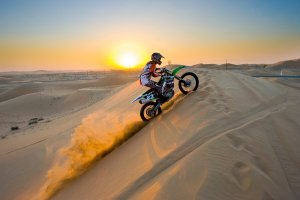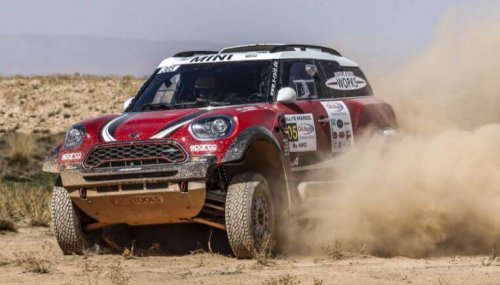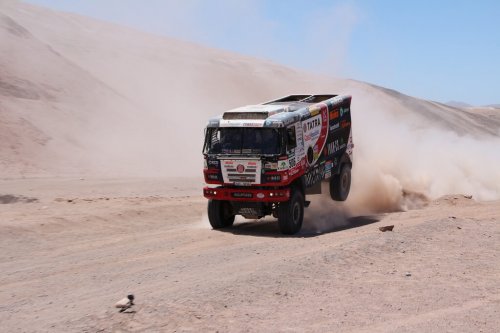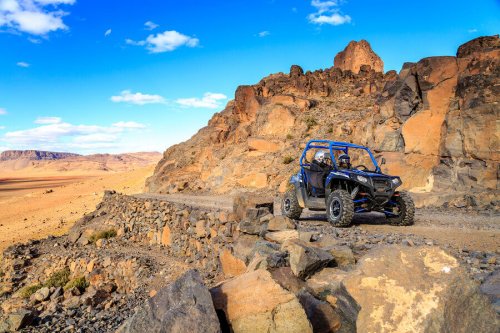Dakar Rally Vehicles: Extreme Races

Every year, the Dakar Rally vehicles present incredible images of cars, motorcycles, ATVs, and trucks crossing wonderful landscapes that are also inhospitable. In the following article, we’ll tell you everything you need to know about the extreme races of the Dakar Rally.
A brief history of the Dakar Rally vehicles
This is a relatively new event; it was created in 1978 after a French competitor, named Thierry Sabine, was lost in the desert in North Africa for six days. Instead of being traumatized, he thought that this experience could become something worth replicating, but as a competition.
At first, the races weren’t highly organized and many competitors were amateurs who had off-road vehicles. All this has changed; today, they’re all professionals and have GPS navigation systems. Also, the Dakar Rally is broadcast on television.
Another thing that has changed over time is the route layout. Until 1994, the races would take place in the original route, which starts in Paris and continues to Africa. After that year, each edition had a different path; this was due to organization, political problems, or wars.
Different race routes: Dakar Rally vehicles
From its beginnings until 1988, the event had venues in Paris, Algiers, and Dakar; hence its name. In 1989, the second venue was Tunisia and, in 1990 and 1991, it was Tripoli. Subsequently, in 1992 the route passed through Sirte and Cape Town; in 1993 through Tangier and, in 1995-1996 and 1998-1999, through Granada.

Due to some inconveniences with the French capital, from 2002 to 2007, it didn’t start in Paris, but in Arras, Marseille, Clermont, and Lisbon.
In 2008, the competition had to be canceled due to terrorist threats during the passage through Mauritania. That was the main reason for the transfer of the Dakar Rally to another continent, more precisely, to South America.
The Dakar Rally vehicles in another corner of the planet
In 2009, the organizers were Argentina and Chile. The competition was able to take place in different terrains, such as plains, deserts, and mountains. Later, in 2011, Peru was added to the competition as well as a brief visit to Bolivia.
The races have been able to start in Buenos Aires -2009, 2010, 2011, 2015, and 2016; Mar de Plata -2012; Lima -2013, 2018, and 2019; Rosario -2014; and Asuncion -2017. It also passed through Valpariso, Antofagasta, Arica, Copiapo, San Miguel de Tucuman, Iquique, Salta, La Paz, and Cordoba.
For the 2020 edition, the Dakar Rally will move to Saudi Arabia. Moreover, it will be the only country where the competition will take place.
It will start on January 5th and end on the 17th. The competitors will depart from the city of Jeddah and the race will have 12 stages over desert sand and dirt; including dunes of up to 250 meters high. It’ll pass through the capital and end at Al Qiddiya.

The Dakar Rally vehicles
The number and types of vehicles participating in the Dakar Rally have changed with the passing of each edition. Currently, there are four main categories of competition, with their respective subcategories:
1. Cars
In this group, we can find modified vehicles (T1), serial vehicles (T2), light prototypes (T3), and vehicles with regulations from SCORE International.
2. Motorcycles
It’s the most dangerous category because the drivers are quite exposed, but also the most popular. The maximum participation of motorcycles is 250 per edition, which can partake in competitions or series.
3. Trucks
This is undoubtedly the most surprising category, due to the size of the trucks. They were added to the Dakar Rally in 1999 and are divided into two categories. These are: standard (T4.1) and modified (T4.2). They all have a speed limit of 87 mph due to safety reasons.
4. Quadricycles
Also known as a squad; they are four-wheeled vehicles and the slowest of the Dakar Rally. The International Motorcycling Federation must endorse each one in order for them to compete.

In addition, we can add the Side By Side category (SxS), which is the most recent and fastest-growing. This is due to the fact that the costs of these off-road vehicles are lower than all the others.
Finally, you should note that the top winners of the Dakar Rally are the French, Stephane Peterhansel (bikes and cars) with 13 victories, The Russian, Vladimir Chagin (trucks) with 7 titles, and the Czech, Karel Loprais (trucks) with six races to his credit.
Every year, the Dakar Rally vehicles present incredible images of cars, motorcycles, ATVs, and trucks crossing wonderful landscapes that are also inhospitable. In the following article, we’ll tell you everything you need to know about the extreme races of the Dakar Rally.
A brief history of the Dakar Rally vehicles
This is a relatively new event; it was created in 1978 after a French competitor, named Thierry Sabine, was lost in the desert in North Africa for six days. Instead of being traumatized, he thought that this experience could become something worth replicating, but as a competition.
At first, the races weren’t highly organized and many competitors were amateurs who had off-road vehicles. All this has changed; today, they’re all professionals and have GPS navigation systems. Also, the Dakar Rally is broadcast on television.
Another thing that has changed over time is the route layout. Until 1994, the races would take place in the original route, which starts in Paris and continues to Africa. After that year, each edition had a different path; this was due to organization, political problems, or wars.
Different race routes: Dakar Rally vehicles
From its beginnings until 1988, the event had venues in Paris, Algiers, and Dakar; hence its name. In 1989, the second venue was Tunisia and, in 1990 and 1991, it was Tripoli. Subsequently, in 1992 the route passed through Sirte and Cape Town; in 1993 through Tangier and, in 1995-1996 and 1998-1999, through Granada.

Due to some inconveniences with the French capital, from 2002 to 2007, it didn’t start in Paris, but in Arras, Marseille, Clermont, and Lisbon.
In 2008, the competition had to be canceled due to terrorist threats during the passage through Mauritania. That was the main reason for the transfer of the Dakar Rally to another continent, more precisely, to South America.
The Dakar Rally vehicles in another corner of the planet
In 2009, the organizers were Argentina and Chile. The competition was able to take place in different terrains, such as plains, deserts, and mountains. Later, in 2011, Peru was added to the competition as well as a brief visit to Bolivia.
The races have been able to start in Buenos Aires -2009, 2010, 2011, 2015, and 2016; Mar de Plata -2012; Lima -2013, 2018, and 2019; Rosario -2014; and Asuncion -2017. It also passed through Valpariso, Antofagasta, Arica, Copiapo, San Miguel de Tucuman, Iquique, Salta, La Paz, and Cordoba.
For the 2020 edition, the Dakar Rally will move to Saudi Arabia. Moreover, it will be the only country where the competition will take place.
It will start on January 5th and end on the 17th. The competitors will depart from the city of Jeddah and the race will have 12 stages over desert sand and dirt; including dunes of up to 250 meters high. It’ll pass through the capital and end at Al Qiddiya.

The Dakar Rally vehicles
The number and types of vehicles participating in the Dakar Rally have changed with the passing of each edition. Currently, there are four main categories of competition, with their respective subcategories:
1. Cars
In this group, we can find modified vehicles (T1), serial vehicles (T2), light prototypes (T3), and vehicles with regulations from SCORE International.
2. Motorcycles
It’s the most dangerous category because the drivers are quite exposed, but also the most popular. The maximum participation of motorcycles is 250 per edition, which can partake in competitions or series.
3. Trucks
This is undoubtedly the most surprising category, due to the size of the trucks. They were added to the Dakar Rally in 1999 and are divided into two categories. These are: standard (T4.1) and modified (T4.2). They all have a speed limit of 87 mph due to safety reasons.
4. Quadricycles
Also known as a squad; they are four-wheeled vehicles and the slowest of the Dakar Rally. The International Motorcycling Federation must endorse each one in order for them to compete.

In addition, we can add the Side By Side category (SxS), which is the most recent and fastest-growing. This is due to the fact that the costs of these off-road vehicles are lower than all the others.
Finally, you should note that the top winners of the Dakar Rally are the French, Stephane Peterhansel (bikes and cars) with 13 victories, The Russian, Vladimir Chagin (trucks) with 7 titles, and the Czech, Karel Loprais (trucks) with six races to his credit.
All cited sources were thoroughly reviewed by our team to ensure their quality, reliability, currency, and validity. The bibliography of this article was considered reliable and of academic or scientific accuracy.
- Noriega, J. L. (2007). La cara más solidaria del rally Dakar. Cinco Días.
This text is provided for informational purposes only and does not replace consultation with a professional. If in doubt, consult your specialist.








